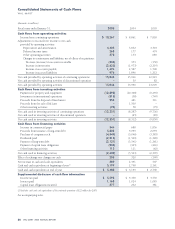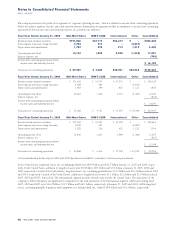Walmart 2005 Annual Report Download - page 40
Download and view the complete annual report
Please find page 40 of the 2005 Walmart annual report below. You can navigate through the pages in the report by either clicking on the pages listed below, or by using the keyword search tool below to find specific information within the annual report.
Notes to Consolidated Financial Statements
W A L -M A R T
38 WAL-MART 2005 ANNUAL REPORT
Leases
The company estimates the expected term of a lease by assuming
the exercise of renewal options where an economic penalty exists
that would preclude the abandonment of the lease at the end of
the initial non-cancelable term and the exercise of such renewal is
at the sole discretion of the company. This expected term is used
in the determination of whether a store lease is capital or operating
and in the calculation of straight-line rent expense. Additionally,
the useful life of leasehold improvements is limited by the expected
lease term. If significant expenditures are made for leasehold
improvements late in the expected term of a lease, judgment is
applied to determine if a change in estimate has occurred, or if the
leasehold improvements may have a useful life that is bound by the
end of the original expected lease term.
Rent abatements and escalations are considered in the calculation
of minimum lease payments in the company’s capital lease tests
and in determining straight-line rent expense for operating leases.
Foreign Currency Translation
The assets and liabilities of all foreign subsidiaries are translated
using exchange rates at the balance sheet date. The income state-
ments of foreign subsidiaries are translated using average exchange
rates. Related translation adjustments are recorded as a component
of other accumulated comprehensive income.
Revenue Recognition
The company recognizes sales revenue net of estimated sales
returns at the time it sells merchandise to the customer, except for
layaway transactions. The company recognizes layaway transactions
when the customer satisfies all payment obligations and takes pos-
session of the merchandise. Customer purchases of Wal-Mart and
SAM’S CLUB shopping cards are not recognized until the card is
redeemed and the customer purchases merchandise by using the
shopping card.
SAM’S CLUB Membership Fee Revenue Recognition
The company recognizes SAM’S CLUB membership fee revenues
both in the United States and internationally over the term of the
membership, which is 12 months. The following table details
unearned revenues, membership fees received from members and
the amount of revenues recognized in earnings for each of the fis-
cal years 2005, 2004 and 2003 (in millions):
Year ended January 31, 2005 2004 2003
Deferred membership fee revenue,
beginning of year $ 449 $ 437 $ 387
Membership fees received 890 840 834
Membership fee revenue recognized (881) (828) (784)
Deferred membership fee revenue,
end of year $ 458 $ 449 $ 437
SAM’S CLUB membership revenue is included in other income, net
in the revenues section of the Consolidated Statements of Income.
The company’s deferred membership fee revenue is included in
accrued liabilities in the Consolidated Balance Sheets. The company’s
analysis of historical membership fee refunds indicates that such
refunds have been nominal. Accordingly, no reserve exists for
membership fee refunds at January 31, 2005 and 2004.
Cost of Sales
Cost of sales includes actual product cost, change in inventory,
the cost of transportation to the company’s warehouses from
suppliers, the cost of transportation from the company’s ware-
houses to the stores and Clubs and the cost of warehousing
for our SAM’S CLUB segment.
Payments from Suppliers
Wal-Mart receives money from suppliers for various programs,
primarily volume incentives, warehouse allowances and reimburse-
ments for specific programs such as markdowns, margin protection
and advertising. Substantially all allowances are accounted for
as a reduction of purchases and recognized in our Consolidated
Statements of Income when the related inventory is sold.
Operating, Selling, General and Administrative Expenses
Operating, selling, general and administrative expenses include all
operating costs of the company that are not related to the transpor-
tation of products from the supplier to the warehouse or from the
warehouse to the store. Additionally, the cost of warehousing and
occupancy for our Wal-Mart Stores segment distribution facilities
are included in operating, selling, general and administrative
expenses. Because we do not include the cost of our Wal-Mart
Stores segment distribution facilities in cost of sales, our gross profit
and gross margin may not be comparable to those of other retailers
that may include all costs related to their distribution facilities in
costs of sales and in the calculation of gross profit and gross margin.
Advertising Costs
Advertising costs are expensed as incurred and were $1.4 billion,
$966 million and $676 million in fiscal 2005, 2004 and 2003,
respectively. Advertising costs consist primarily of print and televi-
sion advertisements. The increase in advertising costs in 2005 and
2004 compared with 2003 is attributable to the adoption of Emerging
Issues Task Force Consensus No. 02-16, “Accounting by a Reseller
for Cash Consideration Received from a Vendor” (“EITF 02-16”).
Upon adoption of EITF 02-16, the company began recognizing
substantially all funds received from vendors as a reduction of
inventory costs. Prior to the adoption of EITF 02-16, the company
recorded a portion of consideration received from vendors as a
reduction of expenses, such as advertising.
Pre-opening Costs
The costs of start-up activities, including organization costs and
new store openings, are expensed as incurred.
























